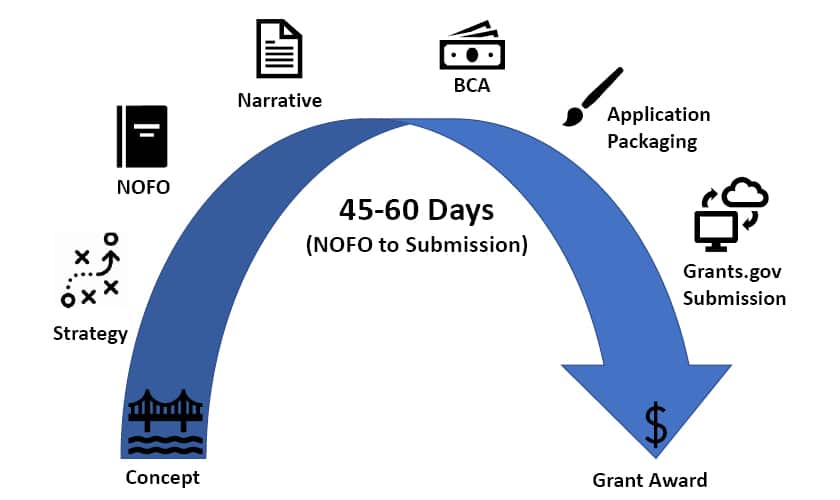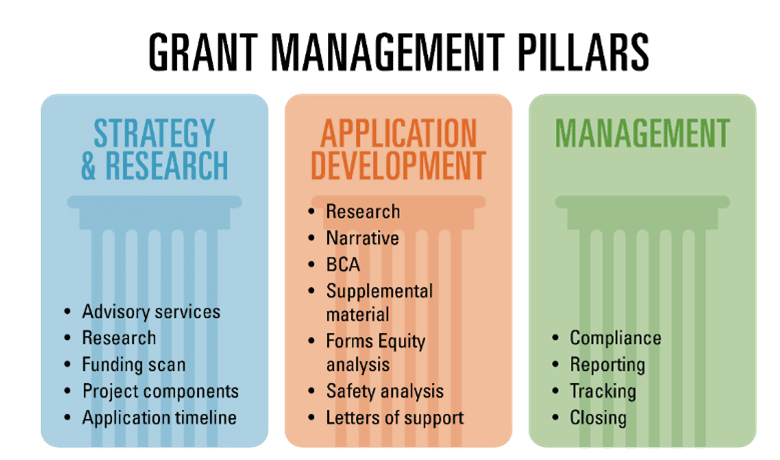
Following last year’s passage of the Infrastructure Investment and Jobs Act (IIJA), public and private clients alike are seeking in-house expertise and guidance on how to most effectively secure the approximate $567.5 billion in grants for upcoming infrastructure projects in the next five years.
Ever-changing rules, regulations and procedures of grant applications make securing funds for capital investments a major task for any team. Coupled with varying application cycles and unique elements required of each submission, a successful grant proposal requires support in strategy, research, applications, and reporting for federal and state grants alike.
In this roundtable discussion, Patricia Macchi, STV’s lead transport economist, and Eric Nelson, planning director, discuss the various types of grants available through the IIJA and consider what changes in funding mean for clients and how STV’s team is best suited to help them navigate the grant process.
Before we discuss STV’s specific services, what kind of projects are eligible for local, state and federal grants?

Patricia Macchi: Every grant has its own unique set of qualifications and criteria to apply, and there are grants for different infrastructure projects from the planning to construction stage, representing market areas such as transportation, water, energy and communications. They’re divided into formula grants – which are based on a qualifying metric such as population – and discretionary grants, which are based on a competitive process. Working as a team, Eric and I support agencies of all sizes with discretionary grant applications.
Eric Nelson: Patricia and I both have long-standing grant application experience. As consultants and outside experts, our job is to be flexible. We’re not beholden to any one ideology – we’re trying to help clients read the tea leaves in the NOFOs (Notice of Funding Opportunity) to provide the client with the historical context of each administration. With the IIJA, discretionary grants comprise more than a quarter (26%) of the total grants for 2022’s fiscal year.
What is the cycle of a major grant? And how does STV help with each part of the cycle?
Eric Nelson: Many consultants would say that a grant cycle begins when the NOFO is released. At that point, we help our clients draft a compelling and data-driven narrative, conduct a benefit-cost analysis (BCA) if needed, outline the letters of support, draft the forms and submit the application. But that’s not the extent of what we do at STV.
Patricia Macchi: Exactly. The lifecycle of a grant begins before the NOFO is published. Eric and I help clients identify project components, strategize funding needs and match local funds with potential applications. This is a constant exercise that allows our clients to be better prepared when NOFOs are released.
Eric Nelson: We’ve also been advising clients on innovative ways to promote their applications, such as partnering with the private sector or another public agency, using social media, etc. It’s a dynamic process.

What are the advantages of having federal grants expertise within a full-service firm like STV?
Eric Nelson: Firstly, our staff is an incredible resource. From risk analysts and safety experts to technical editors and graphic artists, we have the power of a full team behind us. Secondly, as a full-service firm, we can touch a project at all points in its lifecycle. By helping our clients attain discretionary grants, Patricia and I can confer with them about their project team needs very early in the process and bring that information back to our colleagues in design, engineering, and project management.
Patricia Macchi: And while we have the support of our colleagues, Eric and I offer a personalized service. Many of our competitors tend to focus more on simply getting the grant application submitted, but we offer the potential for high-level analysis and capacity building. We help agencies big and small learn about the grant application process and give them the tools to be more successful when pursuing these opportunities. By arming our clients with an understanding of the process, they’re better situated for future applications.
Eric Nelson: For clients, it’s a good idea to outsource grants, given all that goes into compiling, obtaining, and maintaining one.
Patricia Macchi: Agency and project staff are often already working at full steam on their projects. Discretionary grants in particular require lots of management even after they’re obtained – from compliance to tracking and reporting. We bring that extra capacity so they can focus on the project itself, rather than funding it.

What are the impacts of the IIJA on the work that you do?
Patricia Macchi: The IIJA is a once-in-a-lifetime opportunity. In the past, there have been fewer grant funding opportunities. Now, the list has expanded enormously. In previous administrations, the federal government focused its primary discretionary grants program on “shovel ready” projects. The IIJA shifted its focus to projects that support the long-term health of the economy, creating a pipeline of projects to be future-ready. In this way, we can invest in critical infrastructure and multimodal transportation
Eric Nelson: Resources for many of these investments will come through the “alphabet soup” of highly competitive discretionary grants: INFRA, CRISI, RAISE, PIDG, and the new, competitive discretionary grants, such as Reconnecting Communities pilot program, MEGA, the Railroad Crossing Elimination Grant Program, and various others.
With that in mind, what is the future of federal grants as they relate to electric vehicles (EV)?

Patricia Macchi: This is a technology that’s growing and developing alongside the grants. Several discretionary opportunities for transportation projects in general are providing the option for applications to include EV. Several NOFOs explicitly mentioned that electrification-related projects are eligible under traditional and new opportunities.
Eric Nelson: Much of the discretionary funding available for EV is for public transportation, and the Biden administration is very motivated in its pursuit of EV. Federal and state grants are looking at applications that demonstrate which communities receive the benefits of EV – not just who uses the vehicles, but who benefits from reduced noise levels, less pollution, etc.
This raises an interesting point about equity and inclusion in infrastructure. How are federal grants addressing existing disparities?
Eric Nelson: One noteworthy consideration is the Justice40 Initiative, which is the federal government’s goal that 40 percent of overall benefits of federal investments flow to disadvantaged, marginalized, and underserved communities that are burdened by pollution. EV and EV grants will certainly play a big role in this. It’s worth noting that the Justice40 Initiative’s goal is for 40 percent of the benefits, not 40 percent of the funding. So, for example, if a client is building a bus garage, 40 percent of the improvements in bus service would need to benefit those communities.
Patricia Macchi: . The timing couldn’t be better – in June, our firm signed the Equity in Infrastructure Project (EIP) Pledge to increase the number, size, and percentage of historically underutilized businesses. During our grant writing process, we formulate an equity analysis for our clients – just as we do a safety analysis and BCA technical memorandum. This way, we can be strategic in how we approach each grant and offer our clients the tools that best serve them.






